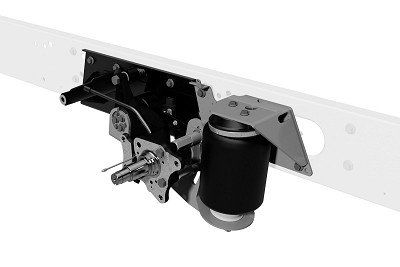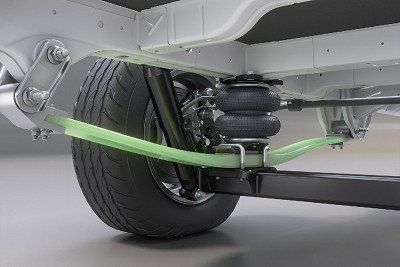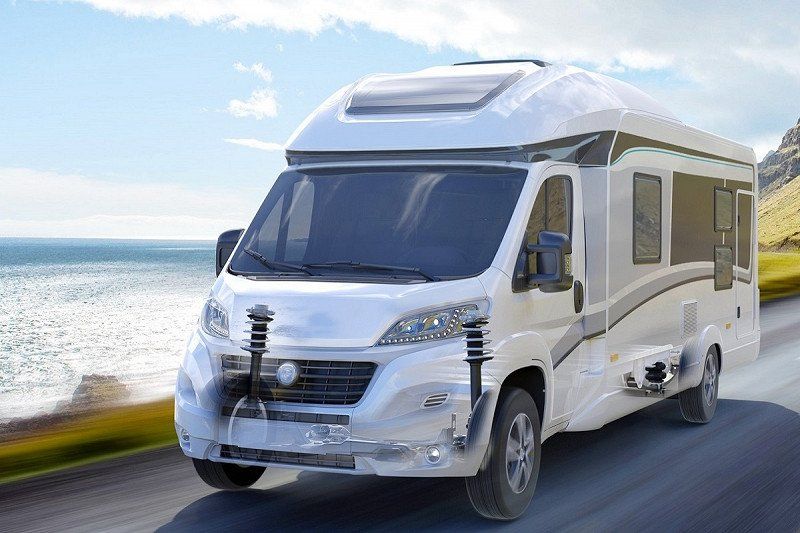Motorhome owners tend to overlook their motorhome or campervan chassis. However, it's worth examining it more closely to see if anything needs to be improved, especially if the following applies: the chassis is suffering from wear and tear from years of continuous use, you want to enhance travelling comfort or intend to increase vehicle load capacity. Freeontour has put together several solutions for you.
Contents
Chassis wear and tear: causes and symptoms
Leaf springs: the cheapest option to upgrade the chassis
More comfort with coil springs
Auxiliary air springs give the rear axle more flexibility
Full air suspension: maximum comfort and flexibility
Different vehicle types require different system solutions
What else to consider

Chassis wear and tear: causes and symptoms
Imprecise handling, decreasing comfort or a low-hanging rear – many symptoms point to an ageing chassis that is getting weaker due to the continuous load. This is the time to act and rejuvenate the base of your motorhome. The base vehicle along with the weight are usually to blame: vans from various automotive manufacturers, such as Fiat Ducato or Mercedes Sprinter, form the basis of most motorhomes. However, a motorhome weighs considerably more than a van that is used for everyday purposes: additional equipment such as awnings, bicycle racks, holiday equipment, passengers, water, fuel, gas, etc. increase the weight of the fixtures and superstructure. This extreme load can make the spring tension weaken over time. A number of solutions are available, depending on the desired degree of travelling comfort.

Leaf springs: the cheapest option to upgrade the chassis
Most of the weight of any motorhome structure rests on the rear axle, which is usually fitted with leaf springs. If the rear of the motorhome sags due to an extremely high load, e.g. due to several bicycles on the rear carrier, this can be counteracted by installing an additional layer of springs. Several companies offer them, including Goldschmitt who has springs for the most common vehicle types, such as Fiat Ducato or Mercedes Sprinter. The straightforward installation and low cost make it an easy decision to add layers of springs to rejuvenate a leaf spring chassis.
If the weight is unevenly distributed between the left and right side of the vehicle, e.g. due to an asymmetrical interior design or heavy attachments on one side, this could cause the motorhome to sag on one side. When it starts to lean, you can straighten it by mounting special metal plates on one side between the spring package and the axle, allowing the vehicle to stand straight again. If you install two of these levelling pieces – one on each side – they will lift the entire rear. It's an inexpensive way of preventing the rear of vehicles with a long rear overhang from bottoming out.

More comfort with coil springs
Since coil springs are inherently much more comfortable than leaf springs, many manufacturers install them on the front axle to improve comfort in the cockpit. However, they are less resilient than leaf springs and can also lose their tension over time. You can solve this problem by fitting reinforced coils springs instead of using the standard springs. As the retrofitted springs are available in different lengths, you can also raise the front of the vehicle at the same time. Therefore, the entire structure can be made higher when combined with the aforementioned levelling pieces on the rear axle. This makes it easier to drive over ramps, especially in a motorhome with a long wheelbase or large rear overhang.
Moreover, coil springs can also support leaf springs with a reduced tension: mounted as an additional spring between the axle and the vehicle frame, the weight of the chassis is then distributed between the leaf and coil springs. This takes pressure off the original suspension, raises the rear of the vehicle back to its standard level and improves handling and comfort.
Goldschmitt not only offers reinforced coil springs, but also a comfort suspension strut especially for campervans, which completely replaces the front spring damper unit on the Fiat Ducato. Therefore, the entire strut is replaced, not just the actual coil spring. As a result, you can significantly increase the comfort of light vehicles such as campers, campervans and box-type vans.

Auxiliary air springs give the rear axle more flexibility
Auxiliary air springs support the rear axle damper in a very similar way as the coil springs do. For this purpose, two air bags are placed between the axle and the vehicle frame, the pressure of which can be adjusted by a compressor to adapt to the different loading conditions. Alternatively, a tyre inflator at the petrol station also does the job. This way, the level of the rear can be adjusted – from the horizontal position when driving under normal conditions to raising it to drive on a ferry ramp or a bumpy road. When it comes to controlling the pressure of the air springs, a distinction is made between one- and two-circuit systems. Both systems allow the two air bags on the rear axle to be filled simultaneously via a joint air line at the push of a button, so that the air pressure in both air bags is the same. However, the two-circuit system has the additional advantage of being able to deflate one side at the touch of a button if necessary. This means that the height of the air spring rear axle can be adjusted to compensate for an uneven load (left - right). However, this requires two independent compressed air circuits. Because of these advantages and because the weight distribution in motorhomes is often very different, the experts at Goldschmitt almost always recommend a two-circuit system to their customers.

Full air suspension: maximum comfort and flexibility
Full air suspension completely replaces the standard springs, unlike auxiliary air springs, which retain them. Moreover, new steering rods replace the wheel guides on the original leaf spring axle. As a result, this system improves travelling comfort, even more so than the auxiliary air springs. There are two versions (both with level sensors) that carry out the complete conversion: a simpler version, i.e. 2-channel air suspension, is installed on the rear axle, whereas the 4-channel air suspension is installed on all four wheels, therefore providing more comfort features. It can automatically compensate different wheel loads as well as raise or lower the entire vehicle.
The control unit automatically supplies the air bags with the required internal pressure, so that the vehicle automatically aligns itself horizontally, regardless of the load, and compensates for rolling movements in curves or crosswinds. Manual intervention is obviously also possible, e.g. to raise or lower the rear. For instance, all full air suspensions from Goldschmitt are equipped with AirDriveControl (with a touch control panel) in order to set and save different operating modes. So "Auto level" automatically levels the vehicle when stationary at the touch of a button – provided it has a 4-channel system. The weighing function determines and displays the axle load at the push of a button. The weight is determined via the air pressure in the respective air bags. Deviations of a mere 5% are possible.
Watch this video to see the practical advantages of a 4-channel full air suspension:
Different vehicle types require different system solutions
Every motorhome chassis has different elements that can or need to be improved, therefore manufacturers of these kinds of systems have developed custom solutions for all common base vehicles. For instance, the Goldschmitt RouteComfort package has been developed for Fiat Ducato and its sister models, in which specially tuned suspension struts on the front axle provide a smoother and more comfortable driving experience. It consists of an optimised spring damper unit and is available in two versions for both the light and the maxi or heavy Fiat Ducato chassis from 2006 and later. They have different shock absorber settings and are fitted according to the actual front axle load.

New from spring 2023: Goldschmitt has expanded its RouteComfort series for light campervans with an ingenious spring combination for the rear axle of a leaf-sprung Fiat Ducato, Citroën Jumper and Peugeot Boxer (2006 and later), which will be available from spring 2023. The leaf spring suspension, made from glass fibre reinforced plastic (GRP) together with an 8-inch air suspension, combines a soft and comfortable spring rate with a customised raising and lowering function. This enables a constant ride height to be maintained, lowering when stationary and the departure angle to be raised. Unlike many other retrofits, the new RouteComfort for a Ducato with a dual leaf suspension does not add any additional weight as the increased weight of the air suspension system is compensated by the lower weight of the GRP material in the leaf spring suspension replacement.
Another advantage of the new RouteComfort solution for campervans: the spring suspension also comes with a 12 V compressor, a soft touch control unit and an illuminated manometer. This enables the load differences to be compensated quickly and efficiently as well as the
Solutions for Mercedes Sprinter and VW T5/T6
The Goldschmitt range also includes chassis technologies for the current Mercedes Sprinter, which is becoming more and more popular for motorhomes. The German suspension specialists have developed a dual-circuit auxiliary air suspension system for all models with single tyres built after 2018, which is intended to improve the suspension properties of overloaded vehicles. Moreover, you can still raise or lower the rear axle as required.
Furthermore, there is a full air suspension system for the rear axle of the rear-wheel drive Sprinter (model 910) in combination with 30 mm wheel spacers for widening the track and stabilisers for the front and rear axles. The Goldschmitt OmniRoad package also has a 4-channel full air suspension for the VW T5 and T6, which also includes special shock absorbers that ensure that larger wheels can move freely. When combined with a different wheel/tyre combination, e.g. 235/65 R17 (not included in the delivery), ground clearance can be increased by up to 75 mm, thereby significantly improving the off-road capability of the VW bus.

What else to consider
As mentioned at the beginning, upgrading or improving the chassis is not only recommended if wear is noticeable or if you want to increase travelling comfort. It can also be a solution if the potential payload of the motorhome is not sufficient to transport holiday equipment in accordance with the law. The magic word is "uprating". This involves increasing the axle load and the permissible total weight entered in the vehicle documents. A lot of the time, this can be achieved by fitting auxiliary springs and getting a modifications report from the chassis manufacturer.
A wide range of spring systems can be used to uprate the vehicle – from additional layers of springs for leaf springs to special coil springs for the front and rear axles through to auxiliary or full air suspension. Obviously, the load capacity of the tyres and rims also has to be able to handle the higher total weight of the vehicle.
Two final points to consider before uprating your vehicle: 1) if you hold a European category B driving licence (for cars), you can only drive motorhomes with a permissible total weight of up to 3.5 tonnes. Otherwise you will need a category C1 driving licence (for medium-sized vehicles), which entitles you to drive motorhomes with a permissible total weight of up to 7.5 tonnes; 2) different countries have different regulations for motorhomes over 3.5 tonnes, e.g. you will need an electronic toll box to drive on the motorway in Austria and the Czech Republic – the motorway permit stickers are only for motorhomes up to 3.5 tonnes.


